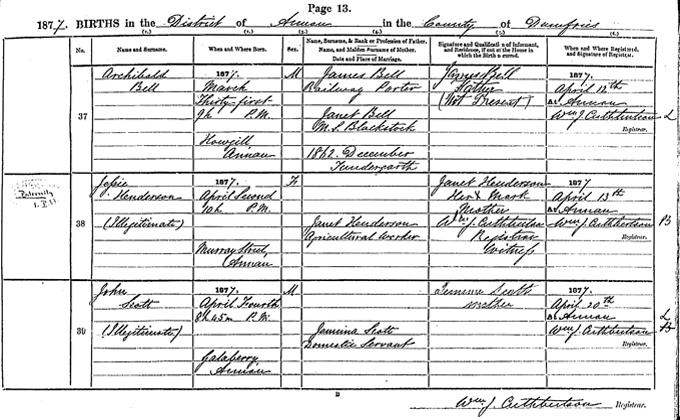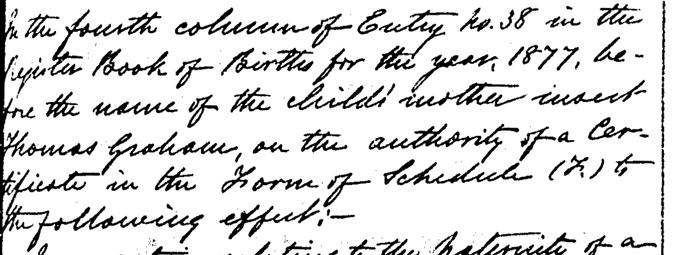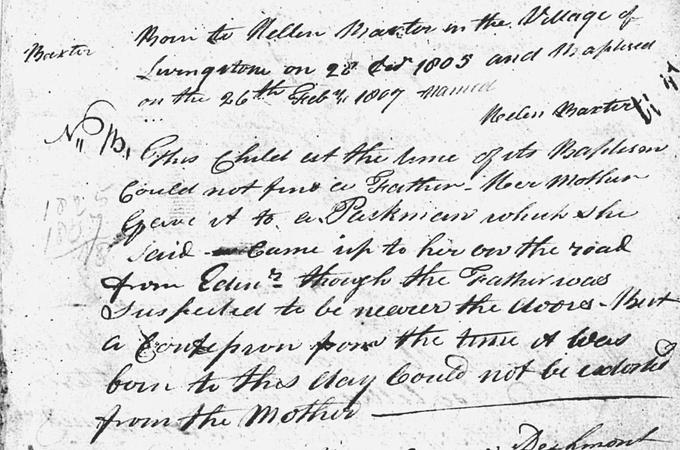Registering illegitimate births
Statutory register of births (1855-1918)
Discontinuation of the word illegitimate
Church registers and kirk session minutes up to 1855
Location of an illegitimate birth or baptism
Statutory register of births (1855-1918)
In Scotland, an illegitimate child’s birth was usually indexed under the mother’s maiden surname. The child may not have been known by that name in later life for several reasons:
- If the parents weren’t married when the child was born, the father’s name could be entered in the register provided he admitted paternity, went with the mother to register the birth and they signed the register together. The child’s birth was then indexed under both the father’s and mother’s surnames. In practice, some were registered only under father’s surname, and known by that name.
- If the parents subsequently married the child was legitimised under Scots law provided the parents were free to marry at the time of the birth. There may be an entry in the Register of Corrected Entries recording the legitimisation of the child’s birth. The birth was indexed under the father’s name retrospectively.
- If the mother subsequently married another man, the child might be recorded under the stepfather’s surname in later records. Since there were no legal adoption procedures before the Adoption of Children (Scotland) Act 1930, the child might assume the stepfather’s surname without any change being made to the birth record.
- If a child was born to a married woman and the father was not her husband you may find this indicated in column one.
Register of Corrected Entries
You will find '(Illegitimate)' in column one of statutory birth records under the name and surname. If an entry for an illegitimate child doesn't have the father’s name recorded, check the left hand column for a reference to an entry in the Register of Corrected Entries (RCE) relating to the paternity of the child.
In this example from the 1877 statutory register of births for Annan two are recorded as illegitimate births but only entry 38 has an RCE reference.

Page from statutory register of births (National Records of Scotland, 1877/812/37-39)
This detail from the RCE entry shows that the child's father had been identified and that his name is to be entered in column four alongside that of the mother. Click on the image to view the full RCE page.

Detail from RCE image relating to statutory birth record (National Records of Scotland, 1877/812/38)
Discontinuation of the word illegitimate
On 26 December 1918 James Patten MacDougall, Registrar General for Scotland, issued a circular to registrars which stated that:
'... it has been resolved to discontinue the use of the word "(Illegitimate)" in dealing with the registration of the births of illegitimate children, as also in the registration of deaths of persons of illegitimate births'.
The amended instructions came into operation on 1 January 1919. As the change applied retrospectively registrars were authorised to omit the word '(Illegitimate)' when issuing certificates (extracts) of 'births of illegitimate children and deaths of illegitimate persons registered in past years'. If you order an official copy of a statutory birth or death record with an RCE it will be supplied with any corrections or insertions applied. Digital images of statutory birth records and RCEs that you can view on this website are as the original register pages.
Church registers and kirk session minutes up to 1855
Baptism entries may indicate that a child was illegitimate by the use of words like natural, baseborn and reputed. In addition, or alternatively, the father or mother may be described as adulterer, fornicator or fornicatrix.
There are references to illegitimate births in the minutes of the kirk session of the parish in which the birth took place. The kirk session, minister and elders of the parish church, dealt with, amongst other things, the moral behaviour of the parishioners. Adulterers, fornicators, drunkards, slanderers and Sabbath breakers were all brought before the kirk session to answer for their behaviour and to do penance for their crimes. In the case of an illegitimate birth, the father’s name might be recorded along with the penance committed by both parents, for example:
- Having to make a public confession and profess their repentance before the congregation
- Being forbidden to take communion for a set period of time
- Having to pay a fine to poor relief.
In cases where the father was unknown, the mother was put under pressure to name him. Sometimes an alleged father would dispute the mother’s allegations. If the mother resisted all attempts to discover the father’s name, the child would be recorded under the mother’s name, as this example from the Livingston OPR for illustrates:

'Born to Hellen Baxter in the Village of Livingston on 28 Decr 1805 and Baptized on the 26th Feby. 1807 named Helen Baxter. N.B. This Child at the time of its Baptism could not find a Father. Her Mother gave it to a Packman which she said came up to her on the road from Edinr though the Father was suspected to be nearer the doors. But a confession from the time it was born to this day Could not be extorted from the Mother.’
Click on the image to view the full Old Parish Register page (National Records of Scotland, OPR 669/1, page 172).
If the baptism of an illegitimate child did take place, after suitable penance by parent or parents, you may find that the child was registered under:
- Mother’s maiden name and retained that name into adulthood;
- Mother's maiden name, then was legitimised by the parents' subsequent marriage and therefore carried the father's surname into adulthood;
- Father’s name if he acknowledged paternity.
Location of an illegitimate birth or baptism
Consider the possibility that an illegitimate child may have been born in a different location to younger children in the family. A young unmarried mother may have been sent away from home for the confinement. It was also common practice, to conceal illegitimacy, for the child to be brought up by the grandparents as the parents.
Census records
You may find an indication of illegitimacy in the census, if, for example, a child’s name is recorded at the end of the entry, or is found to be out of the age-order of the other children in the household.
